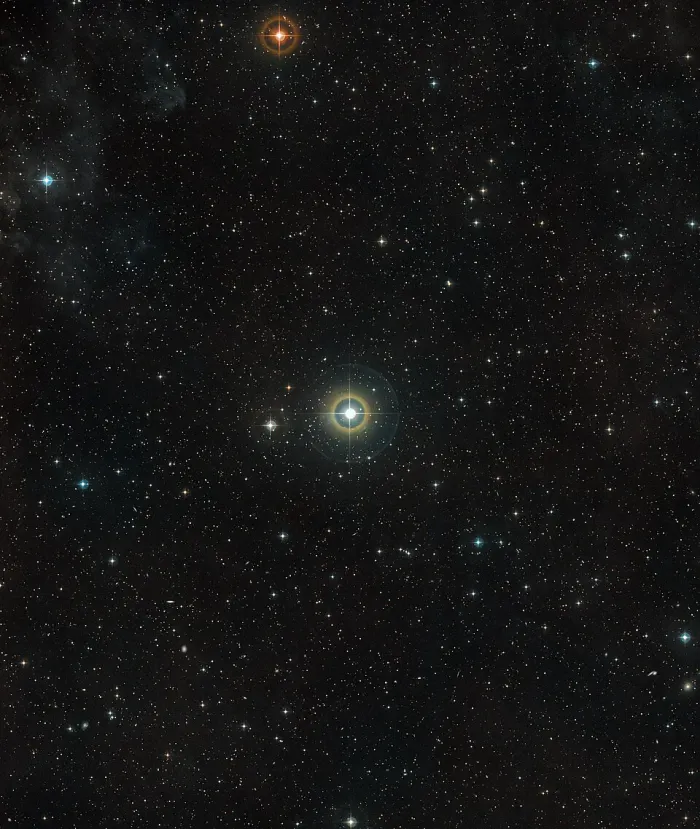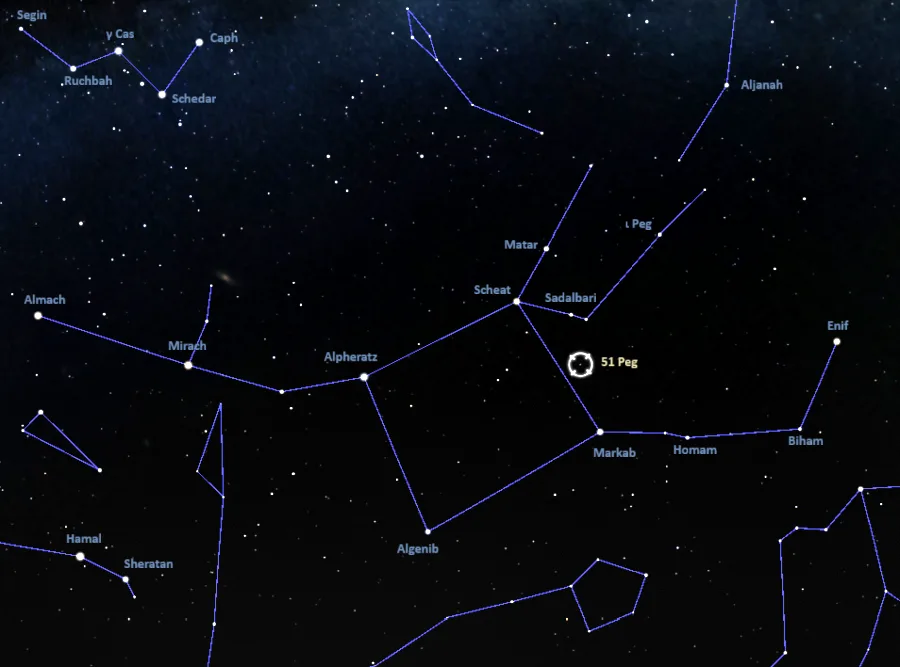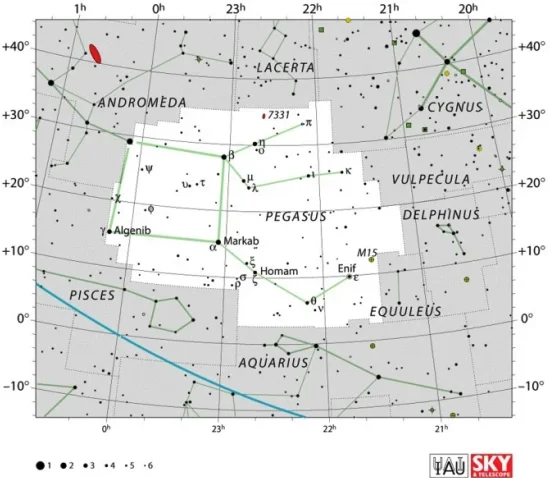51 Pegasi (Helvetios) is a Sun-like yellow main sequence star located 50.64 light-years away in the northern constellation of Pegasus. With an apparent magnitude of 5.49, the star is faintly visible to the unaided eye in exceptionally good conditions. In 1995, it became the first main sequence star discovered to have an orbiting extrasolar planet. The planet, 51 Pegasi b, serves as the prototype for a class of planets known as hot Jupiters. Traces of water were detected in its atmosphere in 2017.
Star type
51 Pegasi is a yellow dwarf of the spectral type G2V+. The Sun-like star has a mass of 1.09 solar masses and a radius of 1.152 solar radii. With a surface temperature of 5,768 K, it shines with 1.398 solar luminosities. It has an estimated age of around 4.8 billion years.
The star spins at 2.54 km/s, taking around 21.9 days to complete a rotation. It is moving in the direction of the solar system with a radial velocity of -33.33 km/s.
51 Pegasi was once classified as a yellow subgiant and served as a spectral standard for the class G2IV in The Perkins catalog of revised MK types for the cooler stars (1989). However, more recent sources list it as a main sequence star that is still fusing hydrogen in its core.
51 Pegasi is believed to be slightly more evolved than the Sun. It has a higher metallicity – amount elements heavier than hydrogen and helium – than our parent star.
Helvetios hosts an orbiting extrasolar planet, 51 Pegasi b. Discovered in 1995, the hot Jupiter was the first exoplanet detected orbiting a main sequence star. It is the only known planet orbiting 51 Pegasi.

Helvetios (51 Pegasi), image credit: ESO/Digitized Sky Survey 2 (CC BY 4.0)
51 Pegasi b
51 Pegasi is a gas giant exoplanet orbiting close to its parent star, 51 Pegasi. It serves as the prototype for a class of gas giant planets called hot Jupiters. These planets have similar physical properties to Jupiter but have considerably shorter orbital periods, resulting in higher surface and atmosphere temperatures. 51 Pegasi b has an estimated temperature of around 1,500 K (1,200° C or 2,200° F).
Formally named Dimidium, 51 Pegasi b is larger but less massive than Jupiter. It has a mass of 0.46 ± 0.02 Jupiter masses and a radius of 1.2 ± 0.1 Jupiter radii. It orbits 51 Pegasi with a period of 4.230785 ± 0.000036 days (101.5388 hours) at an orbital distance of 0.0527 ± 0.0030 astronomical units (Earth – Sun distances), corresponding to 7,880,000 ± 450,000 kilometres. This is less than the distance between Mercury and the Sun.
The planet is believed to be tidally locked to its parent star, always facing it with the same side, much like the Moon is tidally locked to Earth.

This artist’s view shows the hot Jupiter exoplanet 51 Pegasi b, sometimes referred to as Bellerophon, which orbits a star about 50 light-years from Earth in the northern constellation of Pegasus (The Winged Horse). This was the first exoplanet around a normal star to be found in 1995. Twenty years later this object was also the first exoplanet to be be directly detected spectroscopically in visible light. Image credit: ESO/M. Kornmesser/Nick Risinger (skysurvey.org) (CC BY 4.0)
51 Pegasi b was discovered by the Swiss astronomers Michel Mayor and Didier Queloz of the University of Geneva based on observations of periodic variations in the radial velocity of 51 Pegasi. The two astronomers developed the ELODIE echelle spectrograph with André Baranne from the Marseille Observatory. The spectrograph was installed at the Observatoire de Haute-Provence and helped astronomers detect over 20 planets, including 51 Peg b.
The discovery of 51 Pegasi b was announced on October 6, 1995. The accompanying study was published in the journal Nature. The discoverers noted that the newly discovered object “might be a gas-giant planet that has migrated to this location through orbital evolution, or from the radiative stripping of a brown dwarf.” At the time, theories of planet formation could not account for the planet’s short orbit and close distance to the star, which is why planetary migration was introduced as a possible explanation.
In 2019, Mayor and Queloz were awarded the Nobel Prize in Physics for “the discovery of an exoplanet orbiting a solar-type star” and for their “contributions to our understanding of the evolution of the universe and Earth’s place in the cosmos.”
The planet was nicknamed Bellerophon by the American astronomer Geoffrey Marcy in 1996. In Greek mythology, Bellerophon was the son of Poseidon and Eurynome, and the greatest hero before Heracles. He was best-known for defeating the Chimera and for taming Pegasus, the flying horse represented by the constellation Pegasus.
However, the International Astronomical Union (IAU) officially approved the name Dimidium for 51 Peg b in 2015.

The first exoplanet discovered around a Sun-like star, 51 Pegasi b made us question what we knew of our universe and launched the search for new worlds. Credit: NASA/JPL-Caltech (PD)
Facts
51 Pegasi b was not the first ever exoplanet to be discovered. In 1992, Polish astronomer Aleksander Wolszczan and Canadian astronomer Dale Frail reported the discovery of two Earth-sized planets orbiting the millisecond pulsar PSR B1257-12. Formally named Lich, the pulsar lies approximately 2,300 light years away in the constellation Virgo. A third planet orbiting the pulsar was discovered in 1994. The three planets were officially named Draugr, Poltergeist, and Phobetor by the International Astronomical Union (IAU) in 2014.
In 2015, a decade after its discovery, 51 Pegasi b became the first exoplanet to be directly detected spectroscopically in visible light. Astronomers led by J. H. C. Martins of the Institute of Astrophysics and Space Sciences (IA), University of Porto, Portugal, used the HARPS instrument (High Accuracy Radial velocity Planet Searcher) on ESO’s 3.6-metre telescope at the La Silla Observatory in Chile to observe the 51 Pegasi system. They reported the detection of evidence for the reflected light from the planet. The detection allowed the researchers to derive a mass of 0.46 Jupiter masses and an orbital inclination of around 80 degrees for the planet. The astronomers concluded that the planet may be an inflated hot Jupiter with a high albedo (fraction of reflected starlight).
In 2017, astronomers detected the presence of water molecules in the atmosphere of 51 Pegasi b. A team of researchers led by J. L. Birkby, Harvard-Smithsonian Center for Astrophysics, observed the planet and its host star with the CRyogenic high-resolution InfraRed Echelle Spectrograph (CRIRES) on the Very Large Telescope (VLT) in Chile and reported a 5,6σ detection of water molecules. They did not detect significant signal from water carbon dioxide and methane.

This image shows the sky around the star 51 Pegasi in the northern constellation of Pegasus (The Winged Horse). In 1995 the first exoplanet to be discovered was detected orbiting this star. Twenty years later this object was also the first exoplanet to be be directly detected spectroscopically in visible light. This image was created from photographic material forming part of the Digitized Sky Survey 2. Credit: ESO/Digitized Sky Survey 2 (CC BY 4.0)
Name
The International Astronomical Union’s (IAU) Working Group on Star Names (WGSN) approved the name Helvetios (pronunciation: /hɛlˈviːʃiəs/) for 51 Pegasi on December 15, 2015. Helvetios is Latin for “the Helvetian.” It refers to the Helvetians (Helvetii), a Celtic tribe that lived in what is now Switzerland in ancient times.
The planet 51 Pegasi b was formally named Dimidium, which means “half” in Latin. The name refers to the planet’s mass being at least half that of Jupiter.
The names Helvetios and Dimidium were selected during the IAU’s NameExoWorlds campaign, launched in 2014. Both names were submitted the Astronomische Gesellschaft Luzern, Switzerland.
Location
51 Pegasi is easy to find because it lies in the region of the Great Square of Pegasus. The Great Square is a bright, large asterism formed by Alpheratz in the constellation Andromeda with Scheat, Markab and Algenib in Pegasus. The Sun-like star appears a little more than halfway between Markab (Alpha Pegasi) and the fainter Sadalbari (Mu Pegasi), along the imaginary line drawn from Alpheratz (Alpha Andromedae) to Enif (Epsilon Pegasi).
At declination +21°, Helvetios is visible from virtually anywhere for at least part of the year. It never rises for observers south of the latitude 69° S.

Location of 51 Pegasi, image: Stellarium
Constellation
51 Pegasi is located in the constellation Pegasus. The mythical flying horse occupies 1,121 square degrees of the sky just north of the celestial equator. It is the seventh largest of the 88 constellations. In Greek mythology, it is associated with Pegasus, the offspring of the Gorgon Medusa and the god Poseidon. Like all Greek constellations, Pegasus was catalogued by the astronomer Claudius Ptolemy of Alexandria in the 2nd century AD.
Dominated by the Great Square asterism, Pegasus is one of the easiest northern constellations to identify. With five stars brighter than magnitude 3.0, it is easily visible even from areas with some light pollution.
Pegasus does not contain any first magnitude stars. Enif (Epsilon Pegasi), the brightest star in Pegasus, is a K-type supergiant with an apparent visual magnitude of 2.399, located approximately 690 light-years away.
Other relatively bright stars in the constellation include the red giant Scheat (Beta Pegasi), the blue subgiant Algenib (Gamma Pegasi), the evolved blue-white star Markab (Alpha Pegasi), the hot blue main sequence star Homam (Zeta Pegasi), the yellow giant Sadalbari (Mu Pegasi), the yellow bright giants Matar (Eta Pegasi) and Lambda Pegasi, and the double stars Biham (Theta Pegasi) and Iota Pegasi.
Pegasus is also home to the orange supergiant 12 Pegasi, the yellow supergiant 9 Pegasi, the chemically peculiar star Salm (Tau Pegasi), and IK Pegasi, one of the nearest supernova candidates to the Sun.

Pegasus constellation map by IAU and Sky&Telescope magazine (Roger Sinnott & Rick Fienberg) (CC BY 3.0)
Deep sky objects in the constellation include the globular cluster M15 (the Great Pegasus Cluster), the spiral galaxy NGC 7331 with the Deer Lick Group, the barred spiral galaxy NGC 7479 (the Propeller Galaxy or Superman Galaxy), the Fried Egg Galaxy (NGC 7742), and the interacting pairs of galaxies NGC 7752 and NGC 7753, and NGC 7469 and IC 5283.
Pegasus also contains the famous visual grouping of galaxies known as Stephan’s Quintet (Hickson 92) and the gravitationally lensed quasar called the Einstein Cross.
The best time of the year to observe the stars and deep sky objects in Pegasus is during the month of October, when the constellation appears higher above the horizon in the early evening. The entire constellation is visible from locations north of the latitude 60° S.
The 10 brightest stars in Pegasus are Enif (Epsilon Peg, mag. 2.399), Scheat (Beta Peg, mag. 2.42), Markab (Alpha Peg, mag. 2.48), Algenib (Gamma Peg, mag. 2.84), Matar (Eta Peg, mag. 2.95), Homam (Zeta Peg, mag. 3.414), Sadalbari (Mu Peg, mag. 3.514), Biham (Theta Peg, mag. 3.52), Iota Pegasi (mag. 3.77), and Lambda Pegasi (mag. 3.93).
Helvetios – 51 Pegasi
| Spectral class | G2V+ |
| U-B colour index | +0.20 |
| B-V colour index | +0.67 |
| Apparent magnitude (V) | 5.49 |
| Apparent magnitude (B) | 6.16 |
| Apparent magnitude (R) | 5.0 |
| Apparent magnitude (I) | 4.7 |
| Apparent magnitude (J) | 4.66 |
| Apparent magnitude (H) | 4.23 |
| Apparent magnitude (K) | 3.91 |
| Absolute magnitude | 4.48 |
| Distance | 50.64 ± 0.04 lgiht-years (15.53 ± 0.01 parsecs) |
| Parallax | 64.4048 ± 0.0543 mas |
| Radial velocity | – 33.33 ± 0.13 km/s |
| Proper motion | RA: +207.328 ± 0.088 mas/yr |
| Dec.: +61.164 ± 0.075 mas/yr | |
| Mass | 1.09 ± 0.02 M☉ |
| Luminosity | 1.398 ± 0.016 L☉ |
| Radius | 1.152 ± 0.009 R☉ |
| Temperature | 5,768 ± 8 K |
| Metallicity | +0.18 ± 0.01 dex |
| Age | 4.8 billion years (4.4 – 5.5 Gyr) |
| Rotational velocity | 2.54(62) km/s |
| Rotation | 21.9 ± 0.4 days |
| Surface gravity | 4.33 ± 0.02 cgs |
| Constellation | Pegasus |
| Right ascension | 22h 57m 27.9804852576s |
| Declination | +20° 46′ 07.797040104″ |
| Names and designations | Helvetios, 51 Pegasi, 51 Peg, HD 217014, HR 8729, HIP 113357, SAO 90896, GJ 882, BD+19°5036, AG+20 2595, PPM 114985, LTT 16750, NLTT 55385, GCTP 5568.00, PLX 5568.00, SKY# 43603, LSPM J2257+2046, GC 32003, GCRV 14411, ASCC 826013, RBR 21A, CNS5 5664, AKARI-IRC-V1 J2257280+204608, JP11 3558, NSV 14374, N30 5052, SPOCS 990, GEN# +1.00217014, ROT 3341, CSV 102222, WEB 20165, USNO-B1.0 1107-00589893, uvby98 100217014, TD1 29480, YPAC 218, TIC 139298196, UBV 19678, UBV M 26734, IRAS 22550+2030, 2MASS J22572795+2046077, TYC 1717-2193-1, YZ 0 1227, YZ 20 9382, Gaia DR2 2835207319109249920, Gaia DR3 2835207319109249920, WDS J22575+2046A |